Louisiana Economy Forecasting Model
As a service to the State of Louisiana, the LSU Department of Economics provides economic forecasts for the state and the 10 metropolitan areas of the state for the current quarter and three quarters ahead.
About the Forecasting Model
At the state level, forecasts are generated for four key economic variables: real Gross State Product (a measure of the real value of goods and services produced within Louisiana, analogous to national real GDP), total non-farm employment, the total unemployment rate, and the Louisiana house price index. At the metro level, due to data limitations, only total non-farm employment is forecast.
The forecasting model consists of a suite of statistical models. The statistical models used are the ones that yielded the best out-of-sample forecasts over a long period of time. The specification procedure replicates what a forecaster would do in real-time to generate out-of-sample forecasts, i.e., estimate a model using data up to the point of the forecast and then forecast out-of-sample.
Use the "Learn More" button below to read a full breakdown of the model's construction. For more information regarding how to read the forecasts, consult the dropdowns under the "Additional Information" section at the bottom of this page.
Notice Regarding Q4 Update
Please note that, due to the federal government shutdown, the Bureau of Labor Statistics and the Bureau of Economic Analysis are running well behind the normal schedule for releasing employment and GDP data for the third quarter of 2025.
Consequently, the forecasts presented below are based on forecasts of data for the third quarter of 2025. Once the official data for the third quarter are released, the forecasts for the 4th Quarter of 2025-3rd Quarter of 2026 will be updated.
Current Louisiana Forecasts
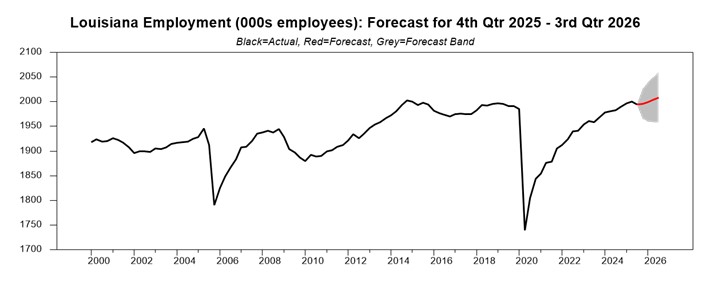
Forecast for Louisiana Non-Farm Employment (Thousands of Employees)
| Quarter | Lower Bound | Forecast | Upper Bound |
| 2025:04 | 1965.71 | 1995.89 | 2026.07 |
| 2026:01 | 1959.60 | 1999.13 | 2038.65 |
| 2026:02 | 1958.14 | 2003.50 | 2048.86 |
| 2026:03 | 1957.06 | 2008.52 | 2059.98 |
Employment is forecast to rise steadily over the forecast horizon but at a slow rate of 0.7%.
Note: because of the effects of the recently ended federal government shutdown on data collection and release, these forecasts are based upon forecasts of third quarter data. When the official 3rd quarter data are released, the forecasts will be updated to reflect the official data.
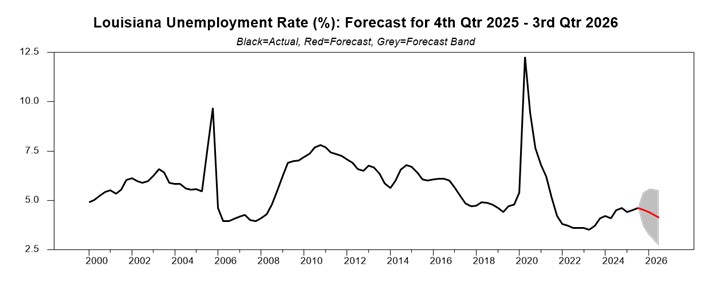
Forecast for Louisiana Unemployment Rate (%)
| Quarter | Lower Bound | Forecast | Upper Bound |
| 2025:04 | 3.67 | 4.54 | 5.40 |
| 2026:01 | 3.26 | 4.41 | 5.57 |
| 2026:02 | 2.96 | 4.26 | 5.57 |
| 2026:03 | 2.70 | 4.11 | 5.52 |
The Louisiana unemployment rate is forecast to slowly fall to 4.1% in the 3rd quarter of 2026.
Note: because of the effects of the recently ended federal government shutdown on data collection and release, these forecasts are based upon forecasts of third quarter data. When the official 3rd quarter data are released, the forecasts will be updated to reflect the official data.
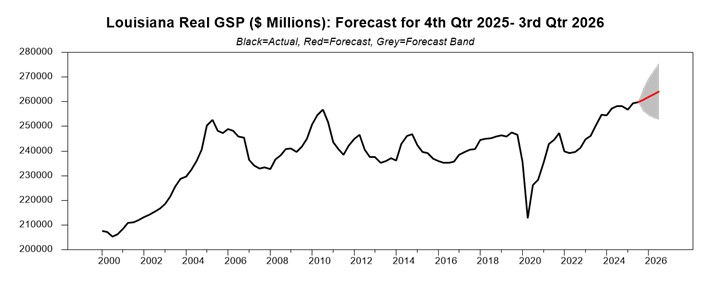
Forecast for Louisiana Real GSP (Millions of $)
| Quarter | Lower Bound | Forecast | Upper Bound |
| 2025:04 | 256242.28 | 260773.80 | 265305.32 |
| 2026:01 | 254551.53 | 261946.15 | 269340.77 |
| 2026:02 | 253416.87 | 263133.21 | 272849.54 |
| 2026:03 | 252685.93 | 264294.95 | 275903.97 |
Real GSP is forecast to rise steadily over the next 4 quarters. The growth rate from the 3rd quarter of 2025 to the 3rd quarter of 2026 is forecast to be 1.7%.
Note: because of the effects of the recently ended federal government shutdown on data collection and release, these forecasts are based upon forecasts of third quarter data. When the official 3rd quarter data are released, the forecasts will be updated to reflect the official data.
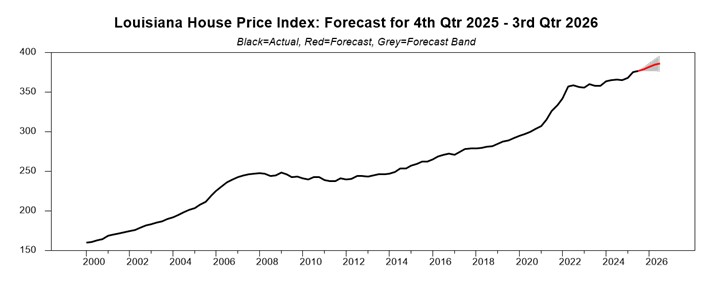
Forecast for Louisiana House Price Index
| Quarter | Lower Bound | Forecast | Upper Bound |
| 2025:04 | 376.11 | 378.97 | 381.84 |
| 2026:01 | 376.48 | 381.89 | 387.31 |
| 2026:02 | 377.17 | 384.72 | 392.28 |
| 2026:03 | 375.86 | 386.06 | 396.25 |
Louisiana house prices are forecast to rise each quarter over the next year. The rate of increase from the 3rd quarter of 2025 to the 3rd quarter of 2026 is forecast to be 2.3%.
Note: because of the effects of the recently ended federal government shutdown on data collection and release, these forecasts are based upon forecasts of third quarter data. When the official 3rd quarter data are released, the forecasts will be updated to reflect the official data.
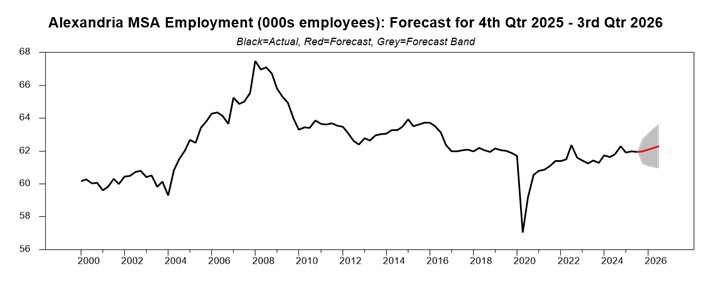
Forecast for Alexandria Metro Area Non-Farm Employment (Thousands of Employees)
| Quarter | Lower Bound | Forecast | Upper Bound |
| 2025:04 | 61.23 | 61.98 | 62.74 |
| 2026:01 | 61.08 | 62.07 | 63.07 |
| 2026:02 | 61.00 | 62.18 | 63.36 |
| 2026:03 | 60.95 | 62.30 | 63.66 |
Employment in the Alexandria metro area is forecast to rise slightly at a rate of 0.6% over the current forecast horizon.
Note: because of the effects of the recently ended federal government shutdown on data collection and release, these forecasts are based upon forecasts of third quarter data. When the official 3rd quarter data are released, the forecasts will be updated to reflect the official data.
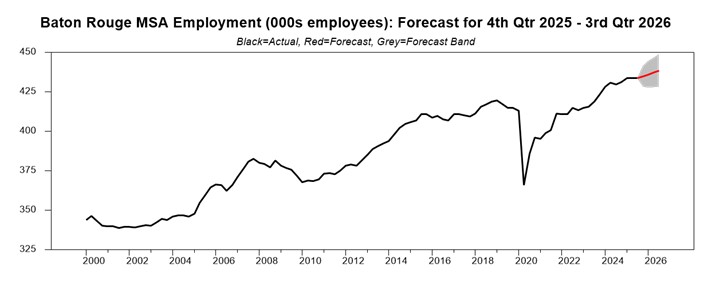
Forecast for Baton Rouge Metro Area Non-Farm Employment (Thousands of Employees)
| Quarter | Lower Bound | Forecast | Upper Bound |
| 2025:04 | 428.31 | 434.95 | 441.59 |
| 2026:01 | 427.66 | 436.11 | 444.55 |
| 2026:02 | 427.92 | 437.30 | 446.67 |
| 2026:03 | 427.86 | 438.50 | 449.14 |
Employment in the Baton Rouge metro area is forecast to rise in each quarter of the forecast horizon. The rate of growth in employment from the 3rd quarter of 2025 to the 3rd quarter of 2026 is forecast to be 1.1%, the fourth strongest of any of the state’s metro areas.
Note: because of the effects of the recently ended federal government shutdown on data collection and release, these forecasts are based upon forecasts of third quarter data. When the official 3rd quarter data are released, the forecasts will be updated to reflect the official data.
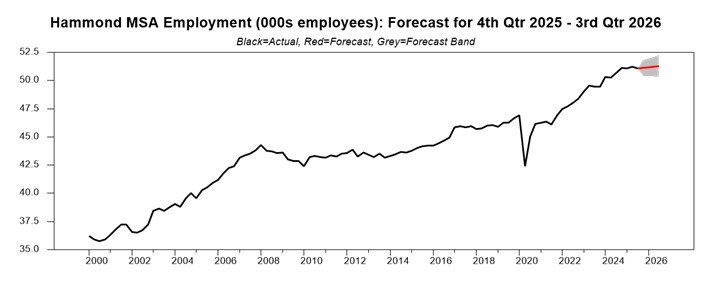
Forecast for Hammond Metro Area Non-Farm Employment (Thousands of Employees)
| Quarter | Lower Bound | Forecast | Upper Bound |
| 2025:04 | 50.44 | 51.12 | 51.80 |
| 2026:01 | 50.38 | 51.18 | 51.98 |
| 2026:02 | 50.39 | 51.24 | 52.09 |
| 2026:03 | 50.33 | 51.30 | 52.26 |
Employment for the Hammond metro area is forecast to be essentially at a standstill, rising at a rate of only 0.4% from the 3rd quarter of 2025 to the 3rd quarter of 2026.
Note: because of the effects of the recently ended federal government shutdown on data collection and release, these forecasts are based upon forecasts of third quarter data. When the official 3rd quarter data are released, the forecasts will be updated to reflect the official data.
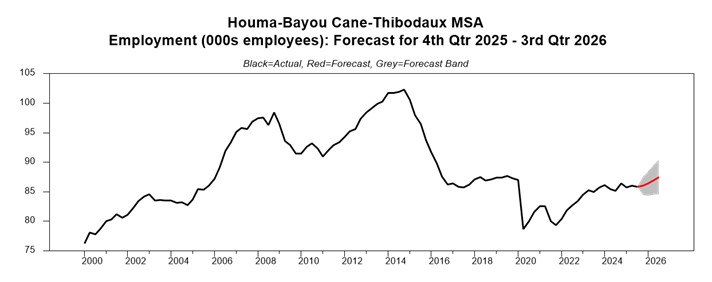
Forecast for Houma-Bayou Cane-Thibodaux Metro Area Non-Farm Employment (Thousands of Employees)
| Quarter | Lower Bound | Forecast | Upper Bound |
| 2025:04 | 84.51 | 85.99 | 87.47 |
| 2026:01 | 84.32 | 86.40 | 88.48 |
| 2026:02 | 84.45 | 86.94 | 89.44 |
| 2026:03 | 84.52 | 87.51 | 90.50 |
Employment in the Houma-Thibodaux metro area is forecast to rise steadily over the forecast horizon. The rate of growth from the 3rd quarter of 2025 to the 3rd quarter of 2026 is forecast to be 1.9%, the second fastest of the state’s metro areas.
Note: because of the effects of the recently ended federal government shutdown on data collection and release, these forecasts are based upon forecasts of third quarter data. When the official 3rd quarter data are released, the forecasts will be updated to reflect the official data.
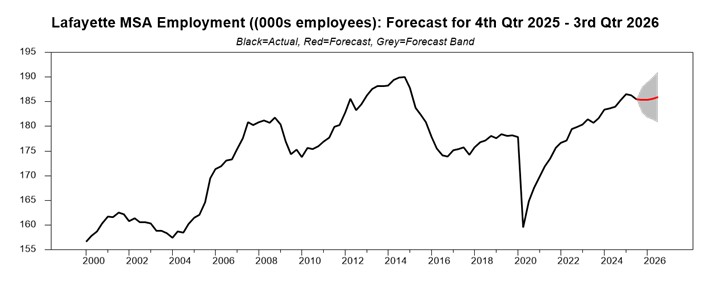
Forecast for Lafayette Metro Area Non-Farm Employment (Thousands of Employees)
| Quarter | Lower Bound | Forecast | Upper Bound |
| 2025:04 | 182.67 | 185.34 | 188.01 |
| 2026:01 | 181.81 | 185.42 | 189.03 |
| 2026:02 | 181.29 | 185.64 | 190.00 |
| 2026:03 | 180.76 | 185.95 | 191.14 |
Employment for the Lafayette metro area is forecast to rise by a small amount over the forecast horizon. The rate of change of employment from the 3rd quarter of 2025 to the 3rd quarter of 2026 is forecast to be a very slow 0.2%.
Note: because of the effects of the recently ended federal government shutdown on data collection and release, these forecasts are based upon forecasts of third quarter data. When the official 3rd quarter data are released, the forecasts will be updated to reflect the official data.
Please note further that Iberia Parish is no longer part of the Lafayette MSA and hence the forecast values after 2025:02 are not directly comparable to those in earlier forecasts.
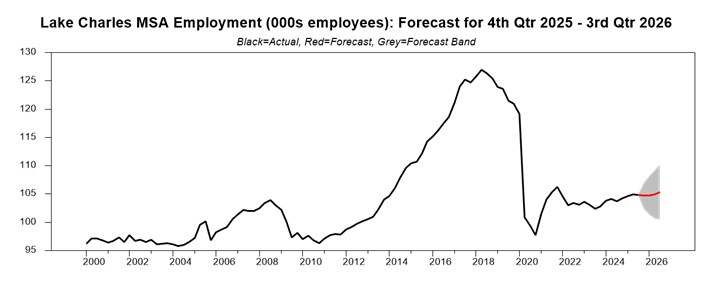
Forecast for Lake Charles Metro Area Non-Farm Employment (Thousands of Employees)
| Quarter | Lower Bound | Forecast | Upper Bound |
| 2025:04 | 102.41 | 104.69 | 106.97 |
| 2026:01 | 101.37 | 104.71 | 108.06 |
| 2026:02 | 100.71 | 104.98 | 109.25 |
| 2026:03 | 100.45 | 105.35 | 110.25 |
Employment in the Lake Charles metro area is forecast to drop slightly in the 4th quarter of 2025 but then rise over the next 3 quarters. The forecast rate of change from the 3rd quarter of 2025 to the 3rd quarter of 2026 is a low 0.6%.
Note: because of the effects of the recently ended federal government shutdown on data collection and release, these forecasts are based upon forecasts of third quarter data. When the official 3rd quarter data are released, the forecasts will be updated to reflect the official data.
Please further note that Jefferson Davis Parish is now part of the Lake Charles MSA and hence the forecast values for 2025:02 and thereafter are not directly comparable to those in earlier forecasts.
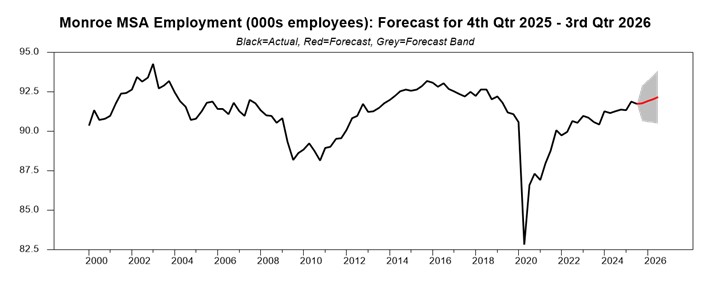
Forecast for Monroe Metro Area Non-Farm Employment (Thousands of Employees)
| Quarter | Lower Bound | Forecast | Upper Bound |
| 2025:04 | 90.66 | 91.77 | 92.89 |
| 2026:01 | 90.57 | 91.91 | 93.25 |
| 2026:02 | 90.56 | 92.03 | 93.50 |
| 2026:03 | 90.48 | 92.17 | 93.86 |
Employment in the Monroe metro area is forecast to rise in each quarter of the forecast horizon. However, the forecast growth rate of employment from the 3rd quarter of 2025 to the 3rd quarter of 2026 is only 0.5%.
Note: because of the effects of the recently ended federal government shutdown on data collection and release, these forecasts are based upon forecasts of third quarter data. When the official 3rd quarter data are released, the forecasts will be updated to reflect the official data.
Please note further that Richland Parish is now part of the Monroe MSA and hence the forecast values for 2025:02 and thereafter are not directly comparable to those in earlier forecasts.
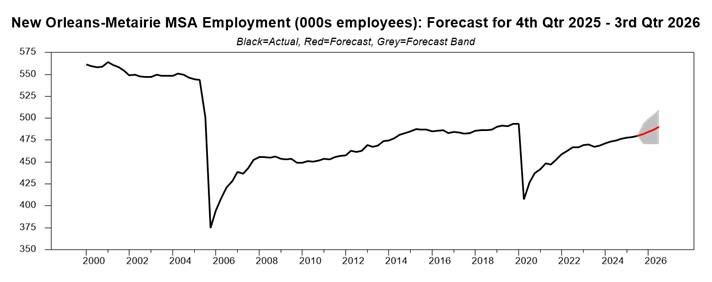
Forecast for New Orleans-Metairie Metro Area Non-Farm Employment (Thousands of Employees)
| Quarter | Lower Bound | Forecast | Upper Bound |
| 2025:04 | 470.57 | 481.92 | 493.27 |
| 2026:01 | 469.72 | 484.53 | 499.34 |
| 2026:02 | 470.10 | 487.32 | 504.53 |
| 2026:03 | 470.44 | 490.16 | 509.88 |
Employment in the New Orleans-Metairie metro area is forecast to continue to rebound from the pandemic low. The forecast growth rate from the 3rd quarter of 2025 to the 3rd quarter of 2026 is 2.2%, the strongest of any of the state’s metro areas.
Note: because of the effects of the recently ended federal government shutdown on data collection and release, these forecasts are based upon forecasts of third quarter data. When the official 3rd quarter data are released, the forecasts will be updated to reflect the official data.
Please note that St. Tammany Parish is no longer part of the New Orleans-Metairie MSA and hence the forecast values for 2025:02 and thereafter are not directly comparable to those in the earlier forecasts.
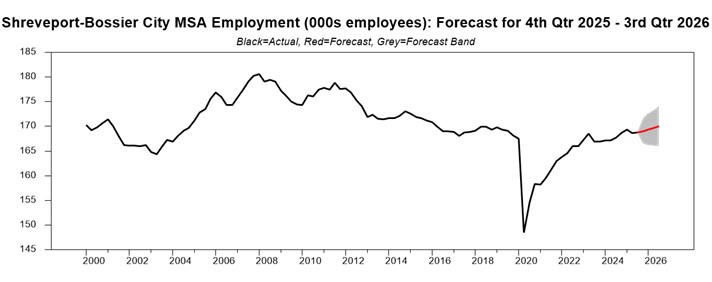
Forecast for Shreveport-Bossier City Metro Area Non-Farm Employment (Thousands of Employees)
| Quarter | Lower Bound | Forecast | Upper Bound |
| 2025:04 | 166.54 | 169.06 | 171.59 |
| 2026:01 | 166.17 | 169.38 | 172.59 |
| 2026:02 | 166.08 | 169.72 | 173.36 |
| 2026:03 | 165.97 | 170.05 | 174.13 |
Employment for the Shreveport-Bossier City metro area is forecast to rise by a small amount over the forecast horizon. The growth rate of employment from the 3rd quarter of 2025 to the 3rd quarter of 2026 is forecast to be 0.7%.
Note: because of the effects of the recently ended federal government shutdown on data collection and release, these forecasts are based upon forecasts of third quarter data. When the official 3rd quarter data are released, the forecasts will be updated to reflect the official data.
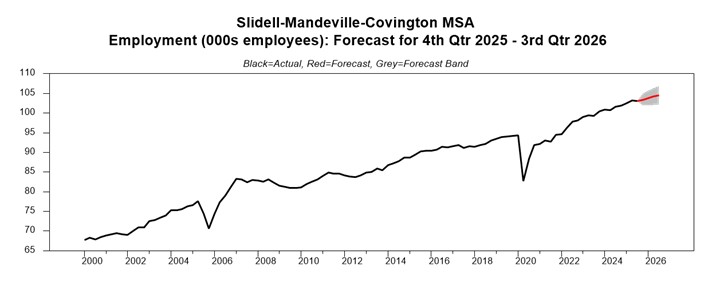
Forecast for Slidell-Mandeville-Covington Metro Area Non-Farm Employment (Thousands of Employees)
| Quarter | Lower Bound | Forecast | Upper Bound |
| 2025:04 | 101.88 | 103.42 | 104.96 |
| 2026:01 | 101.89 | 103.78 | 105.67 |
| 2026:02 | 102.07 | 104.17 | 106.28 |
| 2026:03 | 102.26 | 104.59 | 106.92 |
Employment in the Slidell-Mandeville-Covington MSA is forecast rise steadily over the forecast horizon. The growth rate from the 3rd quarter of 2025 to the 3rd quarter of 2026 is forecast to be 1.4%, the third fastest growth of the state’s metro areas.
Note: because of the effects of the recently ended federal government shutdown on data collection and release, these forecasts are based upon forecasts of third quarter data. When the official 3rd quarter data are released, the forecasts will be updated to reflect the official data.
Please note further that this is a new MSA that comprises St. Tammany Parish.
Additional Information
Two of the statistical models—a state-level model and a national model—are Bayesian Vector Autoregressive Models (BVARs) and the remaining models are single-equation autoregressive models.
Economists have used BVAR models to forecast state and national economic variables. Typically, these models have been found to forecast out-of-sample better than standard Vector Autoregressive (VAR) Models and to be very competitive with larger, more complex, more difficult to specify, and more costly to maintain structural models, often delivering more accurate forecasts. These models are described more completely on the Forecast Addendum page, linked below.
The current forecasting model should be viewed as the first iteration in an ongoing process. Well-specified statistical models can predict accurately when the future is similar to the past. Of course, structural changes can make the future different from the past, and the quality of statistical model forecasts will deteriorate unless the model is adjusted to account for these changes. Consequently, it is necessary to revisit the specifications periodically as more data become available.
The forecasts we present are purely statistical and don’t reflect any subjective adjustments, which are left to the discretion of the forecast user. We provide the best estimate of the variable in each of the four quarters of the forecast (the red line in graphs of the forecast) and a forecast cone (the grey area) that reflects the relative accuracy of past forecasts for that variable at each forecast horizon. The cone “fans” out because the farther ahead we forecast, the less accurate the forecast, a well-known characteristic of economic forecasts.
In 2023, the Office of Management and Budget redefined the Metropolitan Statistical Areas (MSAs) of the U.S. MSAs are defined as territory containing one or more urban areas with at least 50,000 population and the area around the(se) urban area(s) that is(are) highly integrated both economically and socially with the urban area(s). The degree of integration is measured by commuting ties. The most recent release of employment data by the Bureau of Labor Statistics reflects the new MSA definitions.
Louisiana has a new MSA (Slidell-Mandeville-Covington), and some others like, for example, New Orleans-Metairie have been redefined. Consequently, the forecasting models for the old MSAs have been re-specified, and a forecasting model has been generated for the new MSA. The table below provides information on the territory included in each MSA.
Current Louisiana MSAs
| MSA | Principal Urban Area(s) | Parishes |
|---|---|---|
| Alexandria | Alexandria | Grant, Rapides |
| Baton Rouge | Baton Rouge | Ascension, Assumption, East Baton Rouge, East Feliciana, Iberville, Livingston, Pointe Coupee, St. Helena, West Baton Rouge, West Feliciana |
| Hammond | Hammond | Tangipahoa |
| Houma-Bayou Cane-Thibodaux | Houma, Bayou Cane, Thibodaux | Lafourche, Terrebonne |
| Lafayette | Lafayette | Acadia, Lafayette, St. Martin, Vermillion |
| Lake Charles | Lake Charles | Calcasieu, Cameron, Jefferson Davis |
| Monroe | Monroe | Morehouse, Ouachita, Richland, Union |
| New Orleans-Metairie | New Orleans, Metairie | Jefferson, Orleans, Plaquemines, St. Bernard, St. Charles, St. James, St. John the Baptist |
| Shreveport-Bossier City | Shreveport, Bossier City | Bossier, Caddo, DeSoto |
| Slidell-Mandeville-Covington | Slidell, Mandeville, Covington | St. Tammany |
Changes from previous MSA definitions:
- Houma-Thibodaux renamed Houma-Bayou Cane-Thibodaux. No changes in the parishes included in this MSA.
- Lafayette: Iberia Parish removed from this MSA and is no longer a part of any MSA.
- Lake Charles: Jefferson Davis Parish added to this MSA.
- Monroe: Richland Parish added to this MSA.
- New Orleans-Metairie: St. Tammany Parish removed from this MSA and now constitutes the Slidell-Mandeville-Covington MSA.
- Slidell-Mandeville-Covington: new MSA associated with St. Tammany Parish.
For perspective about the Louisiana economy, it is instructive to compare employment, population, real GSP, real GSP per capita, and real GSP per worker in Louisiana to that in other states. Open the PDF addendum linked below to view an in-depth comparison.
The quarterly forecasts of Louisiana employment are for total non-farm employment. This total includes both private sector and government sector employment. To better understand employment trends in Louisiana, the PDF addendum linked below provides historical information on the breakdown of total employment between private sector and government employment and then for specific sectors within the government and private sectors.
More Economics Research from LSU
Questions? Contact Us.
LSU Department of Economics
2300 Business Education Complex
501 South Quad Dr.
Baton Rouge, LA 70803
225-578-5211 | econ@lsu.edu